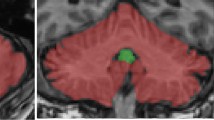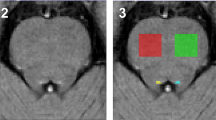Summary
Post-mortem neurochemical studies in Parkinson's disease (PD) have shown that, in addition to the typical nigro-striatal dopamine denervation, there exists a concomitant neocortical monoamine fibre deafferentation (of variable severity) whose role in motor, and especially in associated cognitive and affective impairment, remains elusive. We have extensively examined whether PET imaging with11C-S-Nomifensine (11C-NMF), a radioligand of the dopamine and norepinephrine presynaptic reuptake sites which has been used so far to investigate the striatum, could provide a method for assessing in vivo the neocortical monoamine terminal loss in PD; previously, this has been a little addressed and controversial issue. To this end, we prospectively selected a highly homogeneous sample of nine non-demented, non-depressed idiopathic PD patients with mild to marked side-to-side asymmetry in motor impairment. In addition to recovering the previously-reported correlations withputaminal 11C-NMF specific uptake asymmetries, the clinical motor asymmetries also significantly correlated in the clinically expected direction toneocortical (especially frontal)11C-NMF asymmetries, suggesting the monoamine neocortical denervation might play a direct role in motor impairment in PD. These results demonstrate that it is possible to assess in vivo the neocortical monoamine terminal loss, and to elucidate its potential role in the complex cognitive and affective impairment, in both PD and atypical degenerative parkinsonism.
Similar content being viewed by others
References
Agniel A, Celsis P, Viallard G, Montastruc JL, Rascol O, Demonet JF, Marc-Vergnes JP, Rascol A (1991) Cognition and cerebral blood flow in lateralized Parkinsonism: lack of functional lateral asymmetries. J Neurol Neurosurg Psychiatry 54: 783–786
Alexander GE, Crutcher MD, Delong MR (1990) Basal ganglia thalamo-cortical circuits: parallel substrates for motor, oculomotor, “prefrontal” and “limbic” functions. Prog Brain Res 85, chap 6
Allard P, Eriksson K, Ross SB, Marcusson JO (1990) Unaltered [3H]GBR-1295 binding after chronic treatment with dopamine active drugs. Psychopharmacology 102: 291–294
Allain P, Travère JM, Baron JC, Bloyet D (1993) Accurate PET positioning with reference to MRI and neuroanatomical data bases. In: Uemura K, et al. (eds) Quantification of brain function, tracer kinetics and image analysis in brain PET. Excerpta Media, Amsterdam, p 401
Allain P, Travère JM, Baron JC, Bloyet D (1992) Multimodal analysis of brain images by superimposition of information from PET, 3D-RMI and atlas data bases. Acta Stereologica 11: 181–185 (Proceeding of the Eight International Congress for Stereology 1992)
Aquilonius SM, Bergstrom K, Eckernas SA, Hartvig P, Leenders KL, Lundquist H, Antoni G, Gee A, Rimland A, Uhlin J, Langstrom B (1987) In vivo evaluation of striatal dopamine reuptake sites using11C-nomifensine and positron emission tomography. Acta Neurol Scand 76: 283–287
Aquilonius SM, Langström B, Tedroff J (1989) Brain dopaminergic mechanisms in Parkinson's disease evaluated by positron emission tomography. Acta Neurol Scand 126: 55–59
Arnsten AFT, Goldman-Rakic PS (1985) α2 mechanisms in prefrontal cortex associated with cognitive decline in aged non-human primates. Science 230: 1273–1276
Bäckström IT, Marcusson JO (1990) High-and low-affinity [3H]desipramine-binding sites in human post mortem brain tissue. Neuropsychobiology 23: 68–73
Bernheimer H, Birkmayer W, Hornykiewicz O (1973) Brain dopamine and the syndromes of Parkinson and Huntington. Clinical, morphological correlations. J Neurol Sci 20: 415–455
Brooks DJ, Salmon EP, Mathias CJ, Quinn N, Leenders KL, Bannister R, Marsden CD, Frackowiak RSJ (1990) The relationship between locomotor disability, autonomic dysfunction and the integrity of the striatal dopaminergic system in patients with multiple system atrophy, pure autonomic failure and parkinson's disease, studied with PET. Brain 113: 1539–1552
Brooks DJ (1993) Functional imaging in relation to parkinsonian syndromes. J Neurol Sci 115: 1–17
Firnau G, Sood S, Nahmias C, Garnett ES (1987) Cerebral metabolism of 6-[18F]Fluoro-L-3,4-Dihydroxyphenylalanine in the primate. J Neurochem 48(4): 1077–1082
Fox PT, Perlmutter JS, Raichle ME (1985) A stereotactic method of anatomical localization for positron emission tomography. J Comput Assist Tomogr 9: 141–153
Frost JJ, Rosier AJ, Reich SG, Smith JS, Ehlers MD, Snyder SH, Ravert HT, Dannals RF (1993) Positron emission tomographic imaging of the dopamine transporter with 11C-WIN 35,428 reveals marked declines in mild Parkinson's disease. Ann Neurol 34: 423–431
Garnett ES, Nahmias C, Firnau G (1984) Central dopamine pathways in hemi-parkinsonism examined by positron emission tomography. Can J Neurol Sci 11: 174–179
Gaspar P, Berger B, Febvret A, Vigny A, Henry JP (1989) Catecholamine innervation of the human cerebral cortex as revealed by comparative immunohistochemistry of tyrosine hydroxylase and dopamine-beta-hydroxylase. J Comp Neurol 279: 249–271
Gaspar P, Duyckaerts C, Alvarez C, Javoy-Agid F, Berger B (1991) Alterations of dopaminergic and noradrenergic innervations in motor cortex in Parkinson's disease. Ann Neurol 30: 365–374
Hirai M, Kitamura N, Hashimoto T, Nakai T, Mita T, Shirakawa O, Yamadori T, Amano T, Noguchi-Kuno SA, Tanaka C (1988) [3H]GBR-12935 binding sites in human striatal membranes: binding characteristics and changes in Parkinsonians and schizophrenics. Jpn J Pharmacol 47: 237–243
Hitri A, Venable D, Nguyen HQ, Casanova MF, Kleinman JE, Wyatt RJ (1991) Characteristics of [3H]GBR 12935 binding in the human and rat frontal cortex. J Neurochem 56(5): 1663–1672
Hitri A, Hurd YL, Wyatt RJ, Deutsch S (1994) Molecular, functional and biochemical characteristics of the Dopamine transporter: regional differences and clinical relevance. Clin Neuropharmacol 17: 1–22
Hoehn MM, Yahr MD (1967) Parkinsonism: onset, progression and mortality. Neurology 17(5): 427–442
Javoy-Agid F, Scatton B, Ruberg M, L'Heureux R, Cervera P, Raisman R, Maloteaux JM, Beck H, Agid Y (1989) Distribution of monoaminergic, cholinergic and gabaergic markers in the human cerebral cortex. Neuroscience 29(2): 251–259
Jellinger KA (1991) Pathology of Parkinson's disease. Changes other than the nigrostriatal pathway. Mol Chem Neuropathol 14: 153–197
Kish SJ, Shannak K, Hornykiewicz O (1988) Uneven pattern of dopamine loss in the striatum of patients with idiopathic Parkinson's disease. Pathophysiologic and clinical implications. N Engl J Med 14: 876–880
Leenders KL, Aquilonius SM, Bergström K, Bjurling P, Crossman AR, Eckernas SA, Gee AG, Hartvig P, Lundqvist H, Langström B, Rimland A, Tedroff J (1988) Unilateral MPTP lesion in a rhesus monkey: effects on the striatal dopaminergic system measured in vivo with PET using various novel tracers. Brain Res 445: 61–67
Leenders K, Brown R, Salmon E, Tyrrell P, Perani D, Brooks D, Gotham AM, Sagar HJ, Marsden CD, Frackowiak RSJ (1990) The relationship between “frontal” function in patients with Parkinson's disease and brain dopaminergic activity as measured by PET. Neurology [Suppl] 1: 40 S 168
Leenders KL, Salmon EP, Tyrrell P, Perani D, Brooks DJ, Sager H, Jones T, Marsden CD, Frackowiak RSJ (1990) The nigrostriatal dopaminergic system assessed in vivo by positron emission tomography in healthy volunteer subjects and patients with Parkinson's disease. Arch Neurol 47: 1290–1298
Leenders KL (1994) Mental dysfunction in patients with Parkinson's disease: PET investigations. In: Wolkers E (ed) Mental dysfunction in Parkinson's disease. ICG Publications, Dordrecht, pp 132–139
Lhermitte F, Agid Y, Signoret JL (1978) Onset and end of dose levodopa induced dyskinesia: possible treatment by increasing the daily dose of levodopa. Arch Neurol 35: 261–263
Loeb C, Gandolfo C (1983) Diagnostic evaluation of degenerative and vascular dementia. Stroke 14: 399–401
Loughlin SE, Foote SL, Fallon JH (1982) Locus coeruleus projections to cortex: topography, morphology and collateralization. Brain Res Bull 9: 287–294
Marié RM, Barré L, Allain P, Rioux P, Lechevalier B, Baron JC (1994) Asymmetrical loss of neocortical mono-aminergic (MA) innervation in Parkinson's disease (PD): assessment with (S)-11C Nomifensine [11C-NMF] PET and motoric correlations. Neurology 44(4): S891
Mazoyer B, Trebossen R, Shoukroun C (1990) Physical characteristics of TTV03 a new high spatial resolution time-of-flight positron tomograph. IEEE Trans Nucl Sci 37: 770–782
Miletich RS, Comi G, Bankiewicz K, Plunkett R, Adams R, Di Chiro G, Kopin IJ (1993) 6-18F-Fluoro-L-dihydroxyphenylal anine metabolism and positron emission tomography after catechol-0-methyltransferase inhibition in normal and hemiparkinsonian monkeys. Brain Res 626: 1–13
Montgomery SA, Asberg M (1975) A new depression scale designed to be sensitive to change. Br J Psychiatry 134: 382–389
Nagasawa H, Saito H, Kogure K, Hatazawa J, Itoh M, Fujiwara T, Watanuki S, Seo S, Iwata R, Ido T (1993) 6-[18F]Fluorodopa metabolism in patients with hemiparkinsonism studied by positron emission tomography. J Neurol Sci 115: 136–143
Niznik HB, Fogel EF, Fassos FF, Seeman P (1991) The dopamine transporter is absent in Parkinsonian putamen and reduced in the caudate nucleus. J Neurochem 56(1): 192–198
Perlmutter JS, Raichle M (1985) Regional blood flow in hemiparkinsonism. Neurology 35: 1127–1134
Salmon E, Brooks DJ, Leenders KL, Turton DR, Hume SP, Cremer JE, Jones T, Frackowiak RSJ (1990) A two-compartment description and kinetic procedure for measuring regional cerebral [11C]nomifensine uptake using positron emission tomography. J Cereb Blood Flow Metab 10(3): 307–316
Wawaguchi T, Goldman-Rakic PS (1991) D1 dopamine receptors in prefrontal cortex: involvement in working memory. Science 251: 947–950
Sawle GV, Brooks DJ, Marsden, Frackowiak RSJ (1991) Corticobasal degeneration. A unique pattern of regional cortical oxygen hypometabolism and striatal flurorodopa uptake demonstrated by position emission tomography. Brain 114: 541–556
Scatton B, Dubois A, Dubocovich ML, Zahniser NR, Fage D (1985) Autoradiographic visualization and quantification of dopamine receptors and uptake sites in the rat and human CNS. Life Sci 36: 815–822
Scatton B, Rouquier L, Javoy-Agid F, Agid Y (1982) Dopamine deficiency in the cerebral cortex in Parkinson's disease. Neurology 32: 1039–1040
Schacht U, Leven (1984) Stereoselective inhibition of synaptosomal catecholamine uptake by nomifensine. Eur J Pharmacol 98: 275–277
Talairach J, Tournoux P (1988) Coplanar stereotaxic atlas of the human brain. Thieme, New York
Tedroff J, Aquilonius SM, Hartvig P, Lundquist H, Gee A, Uhlin J, Langstrom B (1988) Monoamine re-uptake sites in the human brain evaluated in vivo by means of11C-nomifensine and positron emission tomography: the effects of age and Parkinson's disease. Acta Neurol Scand 77: 192–201
Tedroff J, Aquilonius SM, Laitinen A, Rinne U, Hartvig P, Anderson J, Lundquist H, Haaparanta M, Solin O, Antoni G, Gee AD, Uhlin J, Langstrom B (1990) Striatal kinetics of [11C]-(+)-nomifensine and 6-[18F]fluoro-L-dopa in Parkinson's disease measured with positron emission tomography. Acta Neurol Scand 81: 24–30
Uhlin J, Gee AD, Malmborg P, Tedroff J, Langstrom B (1989) Synthesis of racemic (+) and (−) N-[methyl-11C]nomifensine, a ligand for evaluation of monoamine re-uptake sites by use of positron emission tomography. Appl Radiat Isot 40: 171–176
Wiener HL, Hashim A, Lajtha A, Sershen H (1989) Chronic L-deprenyl-induced upregulation of the dopamine uptake carrier. Eur J Pharmacol 163: 191–194
Wolfson LI, Leenders KL, Brown LL, Jones J (1985) Alterations of regional cerebral blood flow and oxygen metabolism in Parkinson's disease. Neurology 35: 1399–1405
Author information
Authors and Affiliations
Rights and permissions
About this article
Cite this article
Marié, R.M., Barré, L., Rioux, P. et al. PET imaging of neocortical monoaminergic terminals in Parkinson's disease. J Neural Transm Gen Sect 9, 55–71 (1995). https://doi.org/10.1007/BF02252963
Received:
Accepted:
Issue Date:
DOI: https://doi.org/10.1007/BF02252963




